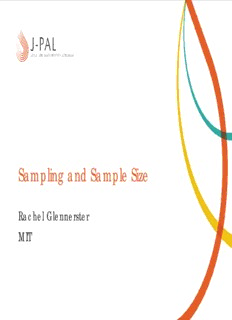
Presentation slides PDF
Preview Presentation slides
Sampling and Sample Size Rachel Glennerster MIT Course Overview 1. What is Evaluation? 2. Measurement & Indicators 3. Why Randomize? 4. How to Randomize? 5. Sampling and Sample Size 6. Threats and Analysis 7. Generalizability 8. Project from Start to Finish J-PAL| SAMPLINGANDSAMPLESIZE 2 Sampling and Sample Size Rachel Glennerster MIT Which of these most likely to describe estimates from 8 well implemented RCTs? I. II. 70% A. I B. II C. Neither 15% 15% A. B. C. J-PAL| SAMPLINGANDSAMPLESIZE 4 Which is the best description of II? I. II. 89% A. Imprecise estimate B. Biased estimate C. Imprecise but unbiased 11% 0% A. B. C. J-PAL| SAMPLINGANDSAMPLESIZE 5 Bias and precision ) e z i S e l p m a S ( n estimates o i s i c e r P truth Less bias (Randomization) J-PAL| SAMPLINGANDSAMPLESIZE 6 Outline • Introduction • Hypothesis testing • What influences power? • Power in clustered designs • Calculating power in practice J-PAL| SAMPLINGANDSAMPLESIZE 7 Outline • Introduction • Hypothesis testing • What influences power? • Power in clustered designs • Calculating power in practice J-PAL| SAMPLINGANDSAMPLESIZE 8 Introduction We evaluate bringing tutors into schools J-PAL| SAMPLINGANDSAMPLESIZE 10
Description: